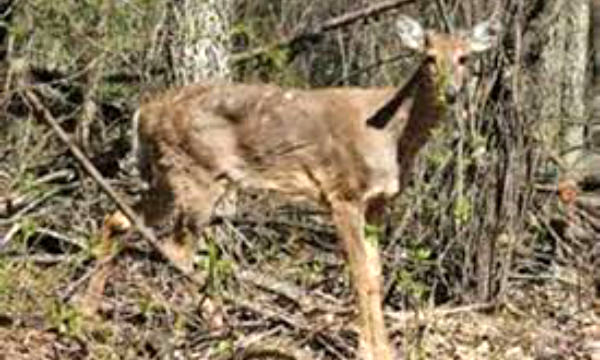SCORES & OUTDOORS: Efforts continue to keep Chronic Wasting Disease out of Maine

A deer afflicted with Chronic Wasting Disease. (Internet photo)
 by Roland D. Hallee
by Roland D. Hallee
As the opening of the Maine firearms deer hunting season approaches, the subject of Chronic Wasting Disease has once again reared its ugly head. Recently, the Maine Department of Inland Fisheries and Wildlife learned of the disease having been detected at a deer farm in Québec Province, Canada, in September.
Chronic Wasting Disease is a prion1, transmissible TSE of mule deer, white-tailed deer, elk, moose, and reindeer. As of 2016, CWD had been found only in members of the deer family. It was first recognized as a clinical wasting syndrome in 1967 in mule deer at a wildlife research facility in northern Colorado. By 1978 it had spread to 23 states.
The disease causes irreversible damage to brain tissue, and there is no known treatments or vaccines. It can be spread by an animal’s bodily fluids and can seep into the soil and remain there for several decades.
This could cause a little inconvenience to folks who like to feed deer. Should an infected deer urinate on the ground near a feeding station, it could pass the disease to other deer who may feed from the ground where the infected deer has urinated. Most infected deer will show increased drinking and urination; the increased drinking and salivation contribute to the spreading of the disease.
Many long-time hunters are fearful that the spread of the disease to Maine would end their hunting activities. Although no cases of human affliction have been confirmed, a study by the Centers for Disease Control and Prevention suggests more laboratory studies are needed to monitor the possibility of such transmission. Hunters are encouraged to avoid eating deer or elk tissues known to harbor the CWD agent, such as brain, spinal cord, eyes, spleen, tonsils, lymph nodes, etc.
Despite the report of the disease from our neighbor to the north, no signs of CWD have been reported in Maine nor New Hampshire, our neighbor to the west. However, that does not dismiss the possibility of it finding its way into our state.
The disease is progressive and always fatal. It has been diagnosed in deer as young as 17 months old. The first signs are difficulties in movement. The most obvious sign is the weight loss over time. From there, a deer’s behavior changes, including decreased interactions with other animals, listlessness, lowering of the head, tremors, repetitive walking in set patterns, and nervousness.
Maine’s deer biologist Nathan Bieber has reported that the fear of the disease has caused a decline in the issuance of hunting licenses. Because the harvesting of female deer has decreased significantly in recent years, a record number of any-deer permits were issued in 2018. The state has issued 54,745 any-deer permits this fall, a 28 percent increase from last year. It is the highest total ever issued since the permit system was instituted in 1986. In total, approximately 170,000 hunting licenses have been issued this hunting season.
The state has been testing for Chronic Wasting Disease in deer since 1999. Bieber said, “In recent years, 450 – 500 deer have been tested, along with about 15 moose.” State officials are introducing legislation to ban feeding deer and deer-urine scents or lures. Neither is an emergency rule, so it could be some time before, and if, the ban becomes reality.
According to the MDIF&W and the Center for Disease Control, it is still safe to eat the meat from deer killed within the state of Maine. Let’s just hope measures and precautions being implemented by these agencies continue to make it safe, and the disease is kept from being transmitted within our borders. There is nothing better than venison steak right out of the frying pan. Add some fiddleheads and it becomes a culinary delight.
1 Prions are misfolded proteins which characterize several fatal neurodegenerative diseases in animals and humans.
Roland’s trivia question of the week:
What did Manny Ramirez, J.D. Drew, Mike Lowell and Jason Varitek, of the Red Sox, do in the same game in 2007?
Answer on page 11.
Responsible journalism is hard work!
It is also expensive!
If you enjoy reading The Town Line and the good news we bring you each week, would you consider a donation to help us continue the work we’re doing?
The Town Line is a 501(c)(3) nonprofit private foundation, and all donations are tax deductible under the Internal Revenue Service code.
To help, please visit our online donation page or mail a check payable to The Town Line, PO Box 89, South China, ME 04358. Your contribution is appreciated!


Leave a Reply
Want to join the discussion?Feel free to contribute!